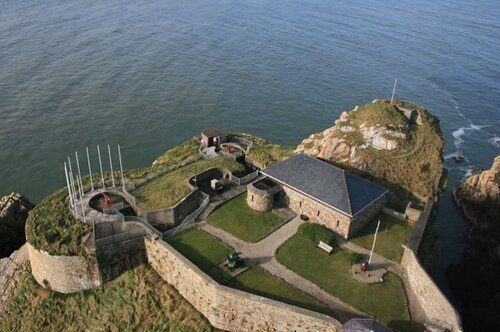This website uses cookies to help deliver its services. By using this website, you agree to the use of cookies as outlined in our Privacy Policy.
There’s lots to do and see!

Malin Head
Malin Head is the location of Ireland’s most Northerly Point. It is a signature point for anyone doing a tour of the Wild Atlantic Way. The tip, Banba’s Crown is named after Banba, a goddess of the Tuatha Dé Danann, the mythological tribe said to have lived in Ireland in ancient times. Banba and her sisters Ériu and Fódla became the patron goddesses representing the sovereignty and the spirit of Ireland.
Standing high at Banba’s Crown is a grey derelict building locally known as ‘The Tower’ Initially constructed by the British Admiralty in 1805 as a Napoleonic lookout tower to help defend against a possible French invasion. It was later taken over by Marconi as an important signal station for news between America and Europe though modern technology has since made it redundant.
In 1870 the first weather reports were recorded, and in 1902 the first wireless message was sent from Malin Head to the ship S.S. Lake Ontario Natural attractions along the cliff edge include a spectacular subterranean cavern known as “Hell’s Hole” and a natural arch called “Devil’s Bridge”. On a good day the Scottish Islands, Tory Island and nearby Inishtrahull Island are visible.
Find out more

An Grianan of Aileach
A prehistoric enclosure built of dry stones on a hill called Grianán, which rises to a height of 808ft and commands views down Lough Foyle as well as extensive panorama covering five counties. The hill we know as an Grianán Ailigh has dominated the landscape of the Northwest for upwards of 4000 years.
The Neolithic burial chamber uncovered during the restoration work in 1870’s dates from 200BC. When the sons of Niall of the Nine Hostages moved North in 395AD to conquer new lands Prince Eoghan (Owen) is said to have made the existing site of Grianán his power base, giving his name to Inishowen (Island of Eoghan) and Tyrone (land of Eoghan). The way of life of this warrior – based society was changed forever by the arrival of Christianity brought by St Patrick, when he was baptised at the well of Grianán.
Find out more

Mamore Gap
This has to be one of the most breathtaking locations in Donegal. Located five miles North of Buncrana, Mamore Gap passes between Mamore Hill and Urris at 800ft above sea level. This is a favourite spot for tourists and locals alike with its spectacular views of the Inishowen Peninsula and beyond to the broad sweep of the Atlantic Ocean. For the energetic it’s the starting point of the Urris Lakes Loop and Butlers Glen Loop Walking Trails.
Find out more

Doagh Famine Village
Doagh Famine Village tells the story of Irish life from the Great Famine of the 1840s through until the present day.
The tour guides will take you on a journey showing how families and communities have lived on the edge generation after generation, adapting and surviving as the environment and society around the local area changed over the years. A combination of informative storytelling and life size exhibits, the famine village provides an informative, thought-provoking and at times humorous looks at Irish life. Attractions include original thatched Irish cottages (inhabited as recently as the 1980s), an Eviction Scene, Orange Hall, Republican Safe House and Irish Wake House amongst others. Doagh Famine Village is visited by thousands of visitors from all walks of life, all ages and from all across the world every year.
Find out more

Wild Ireland
Wild Ireland is a wildlife sanctuary for rescued animals. Visitors can step back in time to an ancient woodland, inhabited by brown bears, wolves, lynx and wild boar. Wild Ireland is a wildlife sanctuary set in a little piece of Celtic rainforest on the Inishowen Peninsula in County Donegal, on the Wild Atlantic Way.
Wild Ireland focuses on animals that were once native to Ireland so they are perfectly adapted to the environment. Brown bears, European wolves and lynx all now live among other animals in large natural habitats back together in the Irish forest for the first time in thousands of years.
There is a lot to see and do for children too. They can take the fairy trail around the rainforest, listen to tales of ancient folklore, play in the play park and finish off with some treats from the Wild Ireland gift shop and coffee shop.
Find out more

Inishowen Maritime Museum
Close to the Lough Foyle ferry landing at Greencastle and on the WAW route, the Inishowen Maritime Museum has an extensive collection of artefacts, exhibitions and memorabilia of all things maritime.
The full dome theatre runs 5 shows each day. As well as astronomy based shows they also offer shows on prehistoric sea monsters, global climate and kids’ favourite – Enchanted Reef! Children’s shows are suitable from 4yrs.
Find out more
The Wild Atlantic Way
Fort Dunree is a Discovery Point on the famous Wild Atlantic Way driving route.
The Wild Atlantic Way, 1600 miles (2600 km) in length, is one of the longest defined coastal routes in the world. It winds its way all along the Irish west coast from the Inishowen Peninsula in the north down to the picturesque town of Kinsale, County Cork, in the south.
This route from start to finish unfolds the wonders of nature, the power of the ocean and its imprint on the west coast of Ireland, and the stunning countryside in all its diversity.
Enchanting villages are nestled along the coast as well as ancient monuments – their origins having long sunk into the mists of oblivion dot the landscape. Behind every bend on this magical coastal road a new delight awaits.
Head along the coast to uncover over 180 Wild Atlantic Way Discovery Points where the views are breath-taking and local stories are told.
Find out more




